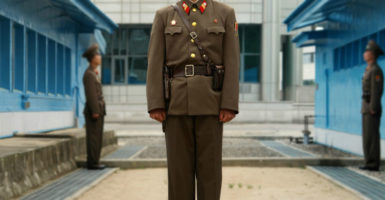Recent satellite images reveal that a North Korean political prison camp, former Camp 18, may have been reopened.
It is unclear when and why this may have happened. The time lag in obtaining detailed information from North Korea means this could be somewhat dated information. But even the possibility that the camp has reopened raises red flags—political prison camps in North Korea have been home to some of the most egregious human rights violations in modern times.
Camp 18, also known as Pukchang political prison camp, was approximately 28 square miles and could hold roughly 27,000 prisoners. It used to be one of the five biggest political prison camps in North Korea.
Camp 18 was situated just across the Taedong River from Camp 14, a similar prison camp. Combined, the two camps held an approximate total of 50,000 political prisoners and their families.
Camp 18 was supposedly shut down sometime around 2006. But since 2011, satellite imagery has shown substantial housing growth in the area.
Recent imagery from Google Earth provides evidence that the camp has in fact been reopened. Images show that a substantial number of houses have been razed and a new security perimeter with guard barracks has been built.
“Immortality Tower,” a statue dedicated to North Korea’s founding dictator Kim Il Sung, had long been an essential element of the residential area, but it has now been removed.
All of this points to the likelihood that either Camp 18 has been reopened, or Camp 14 is expanding.
North Korea has long denied the existence of political prison camps in the country, but various reports on North Korea have confirmed they indeed exist and have been the focus of grave human rights abuses.
In 2014, the United Nations Commission of Inquiry on Human Rights in North Korea (COI) released a report describing “unspeakable atrocities” being committed in North Korea.
It attests that the North Korean regime is responsible for crimes such as “deliberate starvation, forced labor, executions, torture, rape and the denial of reproductive rights enforced through punishment, forced abortion, and infanticide.”
The North Korean government uses political prison camps as a means of keeping the North Korean people in check, often sending as many as three family generations to the camps for committing alleged crimes against the state.
Since the release of the COI report, the international community—including the United States—has admonished North Korea to “dismantle” its prison camps and release political prisoners.
Yet, according to analysis by Amnesty International, Pyongyang “is continuing to maintain, and even invest, in these repressive facilities.” Other new satellite imagery verifies this, confirming “the sustained, if not increased importance of the use of forced labor under Kim Jong Un.”
The United States took a positive step forward in 2016 by sanctioning North Korean Supreme Leader Kim Jong Un and other known human rights violators in North Korea, but much more can and should be done.
The issue of prison camps must be addressed as both a strategic and humanitarian consideration. The U.S. and the international community should develop a feasible plan to hold North Korea accountable for crimes against humanity.


























